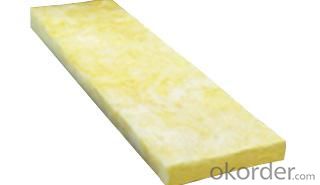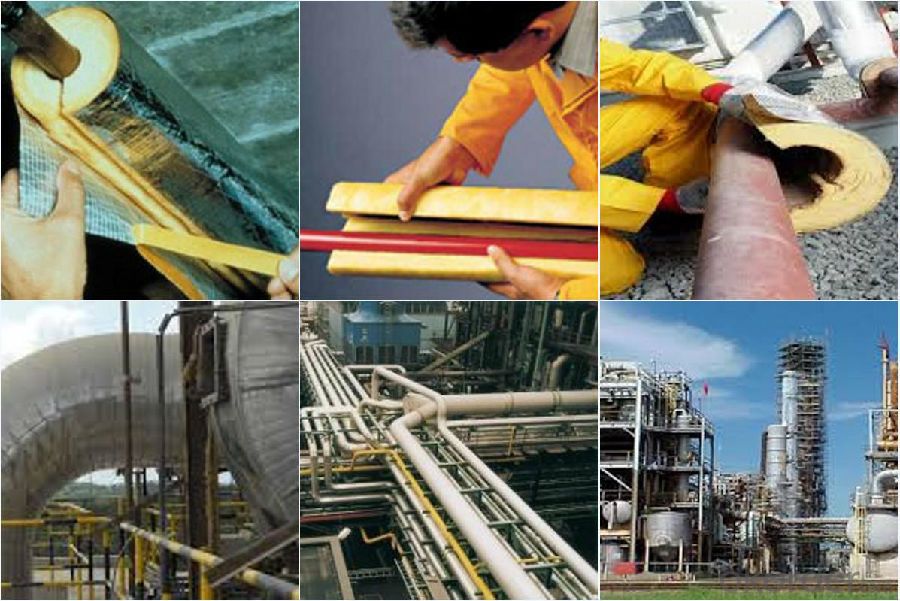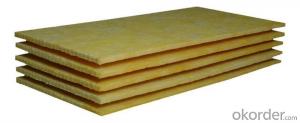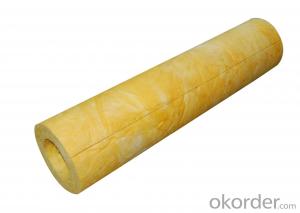Glass Wool Insulation Batt Glass Wool Insulation Materials
- Loading Port:
- Tianjin
- Payment Terms:
- TT OR LC
- Min Order Qty:
- 5000 m²
- Supply Capability:
- 20000 m²/month
OKorder Service Pledge
OKorder Financial Service
You Might Also Like
1.Description of Glass Wool Blanket:
Glass wool, which belongs to glass fiber , is a kind of man-made inorganic fiber. It is made from fibrosis glass melt in wool shape, which belongs to inorganic fiber and fiber in its chemical ingredient. Its merit is better in shape, low density and volume, low in thermal conduction, better heat preservation and thermal insulation, fine sound absorption, corrosion-resistant and stable chemical property. Glass wool blanket, glass wool board, glass wool pipe, which made from glass wool, largely use in construction, chemical, electronic, electricity, metallurgy, energy industry and community with good performance in heat preservation, heat insulation, sound absorption.
2.Main features of Glass Wool Blanket:
a) : fire-resistance
It belongs to upmost fire resistance grade, Class A. It totally meet fire proofing requirement of national standard. It can guarantee the safety of building.
b): heat perversion property
Glass fiber, whose even fiber distribution and reedy fiber lead to lower coefficient of heat conductivity, can ensure its excellent heat-insulating property and long-term heat-preservation.
c): Environmental protection property
Glass wool, which is made from achromatism plate glass and quartz sand, is inorganic heat preservation material. It is a kind of green building material. What’s more, the scrap can be recycled and be reused. It can meet requirement of environmental protection.
3.Glass Wool Blanket Images:


4. Glass Wool Insulation Blanket Technical Parameters:
Property | High/low temperature resistance, oil and fuel resistance, weathering resistance, O zone resistance etc. |
Shape | According to your requirement. |
Color | Any color is available ,according to your requirements. |
Material | NBR, CR, SBR, EPDM, IIR, NR, EP, Silicone, VITON etc. |
Hardness | 30-90ShoreA |
Delivery | In 10 days |
Packing | Plastic bag & carton box or according to your requirements. |
Application | Electronic field, industrial machine & equipment, house-hold appliance, telecommunication, automobile, medical equipment industry etc. |


5.FAQ
We have organized several common questions for our clients,may help you sincerely:
①How about your company?
A world class manufacturer & supplier of Glass Wool Blanket is one of the large scale professional investment casting production bases in China,consisting of both casting foundry forging and machining factory. Annually more than 8000 tons Precision casting and forging parts are exported to markets in Europe,America and Japan. OEM casting and forging service available according to customer’s requirement.
②How to guarantee the quality of the products?
We have established the international advanced quality management system every link from raw material to final product we have strict quality test; We resolutely put an end to unqualified products flowing into the market. At the same time, we will provide necessary follow-up service assurance.
- Q:Can fiberglass mat tissue be used for repairing fiberglass RVs?
- Fiberglass mat tissue is a suitable option for fixing fiberglass RVs. This lightweight and flexible material is commonly employed to strengthen and mend fiberglass structures. Its design allows for easy molding and shaping to conform to the contours of the damaged area, making it an excellent choice for repairing RVs with curved surfaces. To repair a fiberglass RV using fiberglass mat tissue, you must first clean and prepare the damaged area. This involves removing any loose or damaged fiberglass. Next, you cut the mat tissue to the appropriate size and shape, ensuring it covers the damaged area completely. Apply a suitable fiberglass resin or adhesive to both the damaged area and the backside of the mat tissue. Carefully place the tissue over the damaged area, pressing it down firmly to ensure proper adhesion. Once the repair is finished, allow the fiberglass resin or adhesive to cure according to the manufacturer's instructions. After curing, you can sand, prime, and paint the repaired area to match the rest of the RV's exterior. It's crucial to note that fiberglass mat tissue is typically used for smaller repairs and cosmetic damage. For more extensive structural repairs, additional reinforcement materials such as fiberglass cloth or woven roving may be necessary. It is highly recommended to consult a professional or refer to specific repair guides for detailed instructions on repairing fiberglass RVs.
- Q:How does fiberglass mat tissue compare to other types of reinforcement materials?
- Fiberglass mat tissue is a type of reinforcement material that is commonly used in various industries such as construction, automotive, and marine. When comparing fiberglass mat tissue to other types of reinforcement materials, several factors come into play. Firstly, fiberglass mat tissue offers excellent strength and durability. It has high tensile strength, meaning it can withstand considerable pulling or stretching forces without deforming or breaking. This strength is comparable, if not superior, to other reinforcement materials like carbon fiber or aramid fibers. Additionally, fiberglass mat tissue has good resistance to chemical, moisture, and UV degradation, making it suitable for long-term use in various environments. Another advantage of fiberglass mat tissue is its cost-effectiveness. Compared to other reinforcement materials, fiberglass is relatively inexpensive, making it a popular choice for manufacturers and builders who require a cost-efficient solution without compromising on quality. Its affordability makes it accessible to a wider range of applications and industries. Furthermore, fiberglass mat tissue is known for its versatility. It can be molded into various shapes and sizes, allowing for customization and flexibility in design. This adaptability makes fiberglass mat tissue suitable for a wide range of applications, from simple repairs to complex structural reinforcements. However, it is worth noting that fiberglass mat tissue may have some limitations compared to other reinforcement materials. For instance, it may not have the same level of stiffness or strength as carbon fiber, which is often preferred in high-performance applications. Additionally, fiberglass mat tissue may have lower resistance to impact or fatigue compared to materials like aramid fibers. In conclusion, fiberglass mat tissue offers a combination of strength, durability, cost-effectiveness, and versatility that makes it a favorable choice for many applications. While it may have some limitations compared to other reinforcement materials, its overall performance and affordability make it a widely used and reliable option in various industries.
- Q:Is fiberglass mat tissue chemically resistant?
- Yes, fiberglass mat tissue is chemically resistant. Fiberglass mat tissue is made from fine glass fibers that are randomly oriented and bound together with a resin binder. This composition allows the material to exhibit excellent resistance to a wide range of chemicals including acids, alkalis, solvents, and oils. It is commonly used in industries such as chemical processing, petrochemicals, and wastewater treatment where exposure to various chemicals is common. The chemical resistance of fiberglass mat tissue makes it a suitable choice for applications requiring corrosion resistance and long-term durability.
- Q:Can fiberglass mat tissue be used for mold-making?
- Typically, fiberglass mat tissue is not used for mold-making. This lightweight material is made up of randomly oriented glass fibers that are bonded together with a binder. It is commonly utilized in the insulation, construction, and automotive industries for reinforcement purposes. When it comes to mold-making, other materials like silicone, latex, or polyurethane are more commonly employed. These materials possess the necessary properties to create molds that are flexible and capable of reproducing intricate details accurately. Moreover, they are user-friendly and can be poured or brushed onto the original object to form a mold. Conversely, fiberglass mat tissue lacks the flexibility and accuracy required for mold-making. It is not designed to easily conform to complex shapes or capture fine details. Additionally, it may not provide the desired level of flexibility needed to safely remove the original object from the mold without causing damage. Therefore, it is advisable to utilize specific mold-making materials that are specifically designed for this purpose instead of attempting to employ fiberglass mat tissue.
- Q:Is fiberglass mat tissue recyclable?
- Yes, fiberglass mat tissue is recyclable.
- Q:Does fiberglass mat tissue provide any electrical insulation?
- Yes, fiberglass mat tissue provides electrical insulation. Fiberglass is a non-conductive material, meaning it does not conduct electricity. When used as a mat tissue, it acts as a barrier and prevents the flow of electrical current through the material. This makes it suitable for various electrical applications where insulation is required, such as in the manufacturing of circuit boards, electrical panels, and insulating tapes. Additionally, fiberglass mat tissue is known for its high dielectric strength, which further enhances its electrical insulation properties.
- Q:Can fiberglass mat tissue be used for bridge construction?
- Yes, fiberglass mat tissue can be used for bridge construction. It is often used as a reinforcement material in the construction of bridges due to its high strength, durability, and resistance to corrosion. It helps to improve the overall structural integrity and longevity of the bridge.
- Q:Can fiberglass mat tissue be used for insulation in oil refineries?
- No, fiberglass mat tissue is not suitable for insulation in oil refineries. Fiberglass mat tissue is primarily used in construction and automotive industries for reinforcement purposes. It is not designed to withstand the extreme temperatures and corrosive environments found in oil refineries. Instead, insulation materials used in oil refineries are typically made of fire-resistant and chemically resistant materials, such as mineral wool or calcium silicate. These materials are specifically engineered to provide optimal thermal insulation and safety in refinery operations.
- Q:What is the expected lifespan of fiberglass mat tissue in underground applications?
- The expected lifespan of fiberglass mat tissue in underground applications can vary depending on various factors such as the specific conditions of the underground environment, the quality and thickness of the fiberglass mat tissue, and the level of maintenance and care provided. However, on average, fiberglass mat tissue is known for its durability and longevity, making it suitable for underground applications. In general, fiberglass mat tissue is designed to be highly resistant to corrosion, moisture, and other environmental elements commonly found in underground settings. This makes it a reliable choice for applications such as underground pipes, tanks, and other infrastructure where protection against deterioration is crucial. With proper installation and regular maintenance, fiberglass mat tissue can have an expected lifespan of 50 years or more in underground applications. However, it is essential to note that this estimate can vary depending on the specific conditions and usage of the fiberglass mat tissue. To ensure the maximum lifespan of fiberglass mat tissue in underground applications, it is recommended to follow industry best practices, such as proper installation techniques, regular inspections, and addressing any issues, such as cracks or damage promptly. By doing so, the lifespan of fiberglass mat tissue can be extended, providing long-term reliability and durability in underground settings.
- Q:How is fiberglass mat tissue made?
- Fiberglass mat tissue is made by combining thin strands of glass fibers with a binder material, such as polyester or acrylic, to form a non-woven fabric. These glass fibers are typically manufactured through a process called pultrusion, where molten glass is pulled through tiny openings to create continuous filaments. The filaments are then chopped into shorter lengths and dispersed randomly onto a moving conveyor belt. As the fibers move along the conveyor, the binder material is sprayed onto them to ensure adhesion and form a cohesive mat. The mat is then heated to cure the binder and solidify the structure, resulting in a strong and flexible fiberglass mat tissue.
1. Manufacturer Overview |
|
|---|---|
| Location | |
| Year Established | |
| Annual Output Value | |
| Main Markets | |
| Company Certifications | |
2. Manufacturer Certificates |
|
|---|---|
| a) Certification Name | |
| Range | |
| Reference | |
| Validity Period | |
3. Manufacturer Capability |
|
|---|---|
| a)Trade Capacity | |
| Nearest Port | |
| Export Percentage | |
| No.of Employees in Trade Department | |
| Language Spoken: | |
| b)Factory Information | |
| Factory Size: | |
| No. of Production Lines | |
| Contract Manufacturing | |
| Product Price Range | |
Send your message to us
Glass Wool Insulation Batt Glass Wool Insulation Materials
- Loading Port:
- Tianjin
- Payment Terms:
- TT OR LC
- Min Order Qty:
- 5000 m²
- Supply Capability:
- 20000 m²/month
OKorder Service Pledge
OKorder Financial Service
Similar products
New products
Hot products
Hot Searches
Related keywords


























